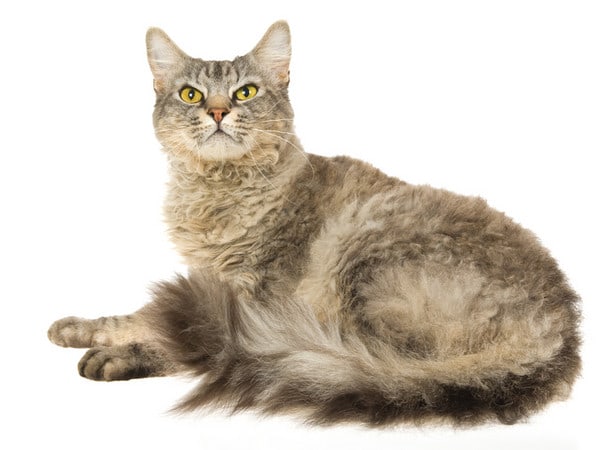Type the name of the breed you're looking for below
[wpdreams_ajaxsearchlite] Don't see the breed your're looking for? Click here and let us know!
Breed Characteristics
1 paw - breed exhibits the least amount of this characteristic
5 paws - breed exhibits most amount of this characteristic
LaPerm
| Origin And History | The kitten that exhibited traits of the original mutation that has formed the basis for the LaPerm breed sprang from strong, healthy, domestic “barn cat” stock. In 1982, on an Oregon farm located near the ancient hunting and fishing grounds of the Wishram Indians, a litter of six kittens was born to a barn cat. One of the kittens was born completely bald – looking nothing like her mother or her littermates. While the kitten had no hair, it did have large wide-spaced ears and blueprint pattern on her skin that mimicked a classic tabby pattern. Within eight weeks, the kitten began to grow very soft, curly hair. At three to four months of age the kitten, now named “Curly,” had a full coat of curly hair. Not being very knowledgeable about cats, the owner accepted the “mutant” as unique and thought nothing more of the matter. During the next 10 years, no attempt was made to breed selectively, but as the frequency of bald kittens increased in the random bred litters, the owner of the farm began to seek additional information about her unusual cats. She had no knowledge of genetics or breeding and thus allowed the cats to roam freely throughout the barns and orchard for several years. As she became aware of how truly unique these cats were, she started to confine the cats and control the breedings. It appeared that the curly gene was dominant and carried by both males and females. This breeder was totally unprepared for the interest and excitement generated by cats she decided to enter in a cat show. The owner gave the cats the name “LaPerm,” which means wavy or rippled. |
| Personality | LaPerms are gentle and affectionate but also very active. Unlike many active breeds, the LaPerm is also quite content to be a lap cat. The LaPerm will often follow your lead; that is, if they are busy playing and you decide to sit and relax, simply pick up your LaPerm and sit down with it, and it will stay in your lap, devouring the attention you give it. LaPerms seek human contact and will purr as soon as they become aware of your presence. They are inquisitive by nature and always want to know what is going on around them. They will reach for your face with their paws and rub their faces against your head, neck, and face. LaPerms are truly different from any other breed of cat because of their unique combination of appearance and people-oriented personalities. The breed has captivated nearly everyone who has the opportunity of seeing one. Once a LaPerm graces your household, you will be hard pressed to think of living with any other breed and may find it necessary to have more than one. Cradling a LaPerm in your arms can touch your senses. Running your fingers through the sensuous coat becomes automatic, and you won’t want to stop. Listening to the purr and seeing the intelligence unfold as you teach your cat tricks, such as fetching, will give you an unmatched feeling of love and respect for the breed. |
Physical Attributes
| Appearance | The LaPerm is in many ways a cat of moderation with no extremes and is still true to its original type. It does however have an unusual coat. The breed standard describes a muscular foreign-type body, which is medium in size with longish legs and neck. The head is a modified wedge with rounded contours and a muzzle which is slightly broad of the wedge. In profile, the straight nose leads into a break between the eyes up to a flattish forehead. LaPerms also have rather broad noses, flared ears and medium large almond shaped eyes. Like other rexes, all colours and patterns are acceptable, although tabbies, reds and torties are quite common due to their origins. Also the unusual colors from the early days of the breed have been selected for, so lilac, chocolate and colour-points are popular. Newer varieties such as ticked tabbies, shaded and darker points are also being bred. The coat itself is described as having a textured feel. It is not silky, having a certain drag on the hand like mohair. It is usually soft, although the shorthairs will have more texture to their coats. The coat is loose and springy, and stands away from the body with no thick undercoat. It is light and airy and judges sometimes blow on the coat to see if it will part. The coat varies according to the season and the maturity of the cat but is essentially wavy or curly with the longest and most defined curls in the ruff and on the neck. There is also longer curly fur inside the ears, tufts at the ear tips and "ear muffs", or longer, silky hair on the backs of the ears. The longhairs have a curly plumed tail while the shorthairs have tails rather like bottle brushes, and both have long curled whiskers. The coat sometimes falls into a natural parting along the back. |
| Health | The LaPerm is a rex breed which originated in the United States and is now present in many other countries worldwide. The breed is genetically unique and not related to any other rex cat varieties, having a dominant gene causing their curly coats. They have an elegant and athletic build and are affectionate, active and outgoing in character. They are reputed to be hypoallergenic cats, provoking a significantly lower level of allergic response in humans than normal cats. |



